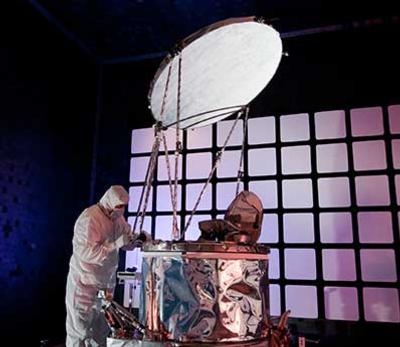Mon, Dec 04, 2017
Will Provide Next-Gen Weather Satellite
The U.S. Air Force Space and Missile Systems Center (SMC) has selected Ball Aerospace to deliver the next-generation operational environmental satellite system, Weather System Follow-on – Microwave (WSF-M), for the Department of Defense (DoD). WSF-M is a predominantly fixed price contract that will provide for system design and risk reduction of a Low Earth Orbit (LEO) satellite with a passive microwave imaging radiometer instrument and hosted Government furnished energetic charged particle (ECP) sensor. The contract will include options for the development and fabrication of two LEO satellites as well as options for launch vehicle integration, launch and early orbit test, and operational test and evaluation support. This mission will improve weather forecasting over maritime regions by taking global measurements of the atmosphere and ocean surface.

"This is an exciting win for us, and we're looking forward to expanding our work with the Air Force and continuing to support warfighters and allies around the world," said Rob Strain, president, Ball Aerospace. "WSF-M extends Ball's legacy of providing precise measurements from space to enable more accurate weather forecasting."
As the prime contractor, Ball will be responsible for developing and integrating the entire microwave system, which includes the microwave instrument, spacecraft and system software.
WSF-M is designed to mitigate three high priority DoD Space-Based Environmental Monitoring (SBEM) gaps: ocean surface vector winds, tropical cyclone intensity and LEO energetic charged particles.
This new environmental satellite system leverages the Ball-built Global Precipitation Measurement (GPM) Microwave Imager (GMI) instrument, which is the on-orbit reference standard for calibrating precipitation measurements in NASA's GPM constellation. The WSF-M bus will be based on the Ball Configurable Platform, a proven, agile spacecraft with 50 years of on-orbit operations for affordable remote sensing applications.
Ball has played key roles on numerous national and international programs that make critical measurements of the physical environment. These include designing and building the weather spacecraft for both the recently launched Joint Polar Satellite System-1 (JPSS-1) and for the Suomi National Polar-orbiting Partnership (Suomi NPP).
(Source: Ball Aerospace news release. Image of GMI instrument provided)
More News
Also: New Lakeland Fly-in!, Gleim's DPE, MOSAIC! Nearly three-quarters of a century in the making, EAA is excited about the future… especially with the potential of a MOSAIC>[...]
Estimated (EST) -When used in NOTAMs “EST” is a contraction that is used by the issuing authority only when the condition is expected to return to service prior to the >[...]
Aero Linx: Regional Airline Association (RAA) Regional airlines provide critical links connecting communities throughout North America to the national and international air transpo>[...]
The Airplane Broke Up In Flight And Descended To The Ground. The Debris Path Extended For About 1,435 Ft. Analysis: The pilot, who was the owner and builder of the experimental, am>[...]
From 2015 (YouTube version): History Comes Alive Thanks to A Magnificent CAF Effort The story of the Douglas C-47 named, “That’s all Brother,” is fascinating from>[...]
 Airborne 07.21.25: Nighthawk!, Hartzell Expands, Deltahawk 350HP!
Airborne 07.21.25: Nighthawk!, Hartzell Expands, Deltahawk 350HP! ANN's Daily Aero-Term (07.27.25): Estimated (EST)
ANN's Daily Aero-Term (07.27.25): Estimated (EST) ANN's Daily Aero-Linx (07.27.25)
ANN's Daily Aero-Linx (07.27.25) NTSB Final Report: Luce Buttercup
NTSB Final Report: Luce Buttercup Classic Aero-TV: 'That's All Brother'-Restoring a True Piece of Military History
Classic Aero-TV: 'That's All Brother'-Restoring a True Piece of Military History



